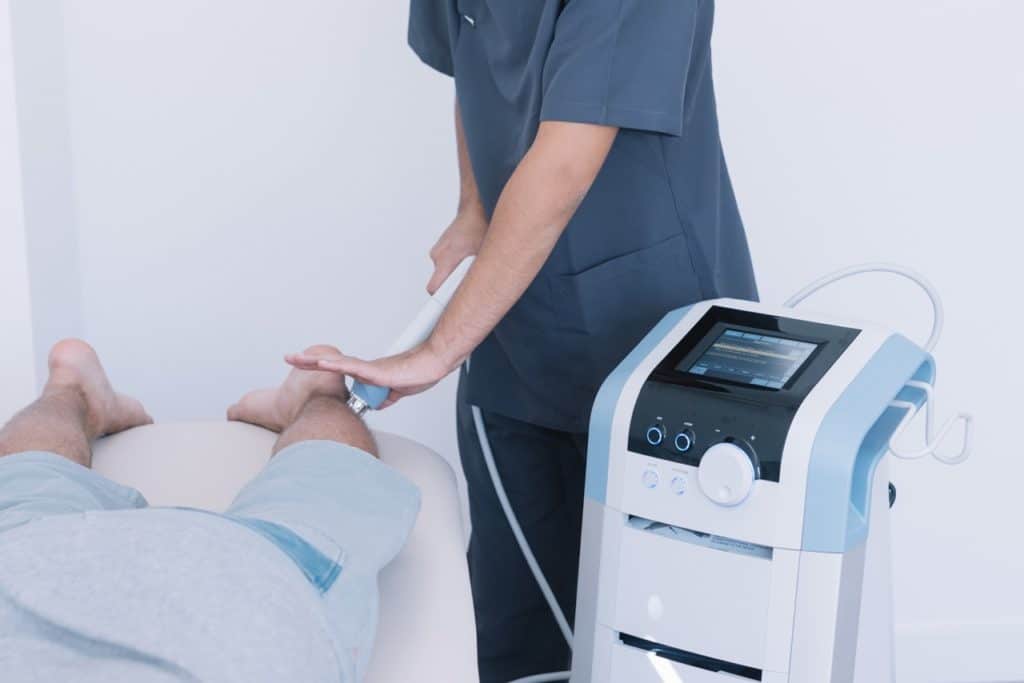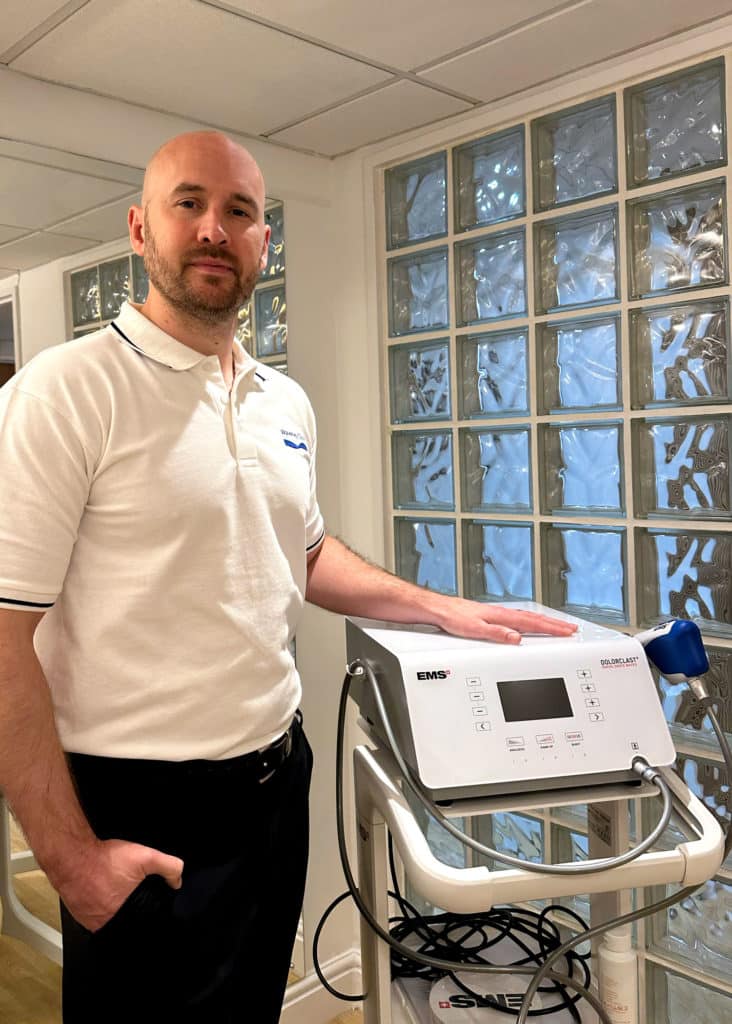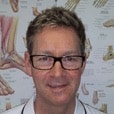Introduction to Achilles tendinopathy
Achilles tendon problems, including Achilles tendinopathy, are common culprits behind heel pain, affecting the Achilles tendon—the band that connects your calf muscle to your heel bone. These problems come in two forms: insertional Achilles tendinopathy, which happens where the tendon meets the heel bone, and mid-portion Achilles tendinopathy, which affects the middle of the tendon. Each type is a bit different and needs its own approach to treatment.
One promising option is shockwave therapy, a non-invasive treatment that’s been showing great results for both chronic mid-portion and insertional Achilles tendinopathy. This condition can affect anyone—whether you’re super active or more on the sedentary side.
There are a few things that can lead to Achilles tendinopathy, like biomechanical issues, training habits, or even certain health conditions. Factors such as leg length differences, overpronation, stiff ankles or hips, and especially pushing your body too hard can all contribute. Weak calves are another big factor, which is why strengthening exercises are key for both preventing and treating the issue.
Healthcare professionals can help diagnose and manage Achilles tendon problems with a mix of simple and advanced treatments. By addressing the root causes and finding the right solution, you can get relief and get back to moving comfortably.

Anatomy of the Achilles tendon
The Achilles tendon is the body’s longest and strongest tendon, playing a key role in movement and stability. Interestingly, unlike most tendons, it doesn’t have a tendon sheath. Instead, it’s surrounded by a vascularised paratenon, which can sometimes get inflamed.
One tricky part of its anatomy is the avascular region located 2-6 cm above where it attaches, which makes this spot more prone to tendinopathy. This area is particularly susceptible to Achilles tendon injury due to its limited blood supply, and injury to the tendon can result from overuse or trauma. Degenerative changes can also occur in the tendon tissue, especially in the avascular region, contributing to the development of tendinopathy.
Understanding the structure of the Achilles tendon is very important when it comes to treating and managing issues like Achilles tendinopathy effectively.
Types of Achilles tendinopathy
Achilles tendinopathy is a pretty common issue affecting the Achilles tendon, causing pain and discomfort at the back of the heel. There are two main types to know about: insertional tendinopathy (also called insertional Achilles tendinopathy) and mid-portion Achilles tendinopathy.
Insertional Achilles tendinopathy happens where your Achilles tendon attaches to your heel bone, right near the retrocalcaneal bursa. It usually causes pain, swelling, and stiffness in the back of your heel, especially around the spot where the tendon connects. A common sign is feeling stiff in the morning, which often goes hand in hand with inflammation and some wear-and-tear at the tendon’s attachment point. For chronic cases, certain treatments, like shockwave therapy, can be really effective.
Mid-portion Achilles tendinopathy, on the other hand, affects the tendon a bit higher up, around 3 cm above the heel bone, and is often caused by overuse or repetitive strain.
Both types may be treated with options such as shockwave therapy. An accurate diagnosis is essential to develop an effective treatment plan, helping you manage symptoms and regain your well-being.
Diagnosis and treatment
The diagnosis of Achilles tendinopathy usually involves a physical examination by a healthcare professional. They may perform various tests to assess your range of motion, strength, and flexibility in the affected ankle and foot. Imaging techniques such as a diagnostic ultrasound scan or ultrasound scan can also be used to confirm the diagnosis and assess tendon health. A diagnostic ultrasound scan provides a detailed assessment of the tendon structure and can help identify partial tears or other issues.
Once diagnosed, initial treatment for Achilles tendinopathy focuses on pain control and inflammation reduction. Conservative treatment is the first line of management and typically includes rest, NSAIDs, and physiotherapy. Therapy for Achilles tendinopathy may also involve physical therapy exercises that strengthen the calf muscles, improve flexibility, and incorporate tendon loading as a key component of rehabilitation. Clinicians treat Achilles tendinopathy with a combination of approaches tailored to the severity and response to initial therapies. A good treatment plan should also tackle the root causes, like imbalances in how your body moves or underlying conditions that might be contributing.
In cases where conservative methods are not effective, shockwave therapy is an increasingly popular option. This therapy for Achilles tendinopathy uses high-energy sound waves to stimulate blood flow and promote healing in the affected area.
In severe cases, surgery may be necessary to repair the damaged tendon. This typically involves removing any damaged tissue and repairing or reinforcing the remaining tendon.
It is important to listen to your body and seek medical attention if you experience persistent pain or discomfort in the Achilles tendon. By taking proper care of yourself and seeking treatment when needed, you can prevent or effectively manage Achilles tendinopathy and continue enjoying an active lifestyle.
Diagnosing and treating Achilles Tendopathy at Waverley Clinic
At Waverley Clinic in Farnham, we understand the importance of staying healthy and active. That’s why we provide expert diagnosis and treatment for Achilles tendinopathy.
During your initial consultation, James, our skilled physiotherapist, will conduct a thorough assessment to accurately diagnose your condition. Our approach to treatment includes tailored exercises, physical therapy, and shockwave therapy to help you recover effectively and get back to your best.
Booking an appointment at Waverley Clinic is simple and convenient. Use our 24/7 online booking system:
You can now book online:
Alternatively, you can call us anytime on 01252 716611. Our seven-day, 24-hour phone service ensures you can schedule your visit at a time that suits you.
Let us help you take the first step towards recovery—book your appointment today!
Shockwave therapy for Achilles tendinopathy
Here at Waverley Clinic, we’re proud to offer Shockwave Therapy (also called Extracorporeal Shock Wave Therapy – ESWT or extracorporeal shockwave therapy), a proven, non-invasive way to treat conditions like plantar fasciitis and Achilles tendinopathy.
This shockwave treatment is delivered by extracorporeal means, meaning the shockwaves are generated outside the body and then directed at the injured area. The shockwaves stimulate the body’s healing process by increasing blood flow and promoting tissue repair.

Shockwave therapy for Achilles tendinopathy has been shown to be effective in clinical studies, with many patients experiencing an immediate reduction in pain after treatment. Studies report positive results and statistically significant improvement in both pain and function. It’s safe, effective, requires little downtime, and is virtually painless—perfect if you’re looking for relief from chronic pain without the hassle.
Our expert physiotherapist, James, will work with you to see if shockwave therapy is the right fit for you. Research shows shockwave therapy is effective in significantly reducing pain and improving movement, especially for Achilles tendinopathy. When combined with other treatments like rehabilitation exercises or physical therapy, clinical outcomes can be even better.
Scientists believe that shockwave therapy speeds up healing and reduces inflammation—helping you get back to your daily life with less pain and more mobility. Ready to try this cutting-edge treatment? Click here to book your shockwave therapy session now!
How many sessions are needed?
The number of shockwave therapy sessions you’ll need for Achilles tendinopathy really depends on how severe the condition is and how your body responds to treatment. On average, most people see great results after 3-5 sessions, typically spaced at weekly intervals. Sometimes, a few extra sessions might be needed to get the best results.
We usually follow a weekly schedule, adjusting the intensity and frequency as you progress. For the best outcome, it’s important to work with our experienced physiotherapist, James Leyland, to create a personalised treatment plan that works for you.
Comparison with other treatments
Shockwave therapy is often compared to treatments like physical therapy, eccentric loading exercises, or steroid injections for Achilles tendinopathy. Eccentric loading is a specific exercise-based approach widely used in tendon rehabilitation, and several randomized controlled trials and systematic reviews have examined eccentric loading compared to shockwave therapy for insertional Achilles tendinopathy, often finding both to be effective options. Shockwave therapy is also frequently considered for recalcitrant Achilles tendinopathy when standard conservative treatments, such as eccentric loading, fail.
When creating a treatment plan, it’s all about weighing the pros and cons of each option and factoring in what works best for your lifestyle and preferences. Shockwave therapy stands out because it’s non-invasive and offers the potential for long-term pain relief, which makes it a popular choice for many people.
Potential risks and side effects
Shockwave therapy is considered a safe option with minimal side effects, like some redness, bruising, or swelling. There is a small risk of more serious complications, such as tendon rupture or soft tissue damage, but these are rare. That said, it’s important to weigh the pros and cons before starting treatment.
This therapy isn’t a good fit for everyone—people with conditions like blood clotting disorders or bone cancer should avoid it. Talking to your healthcare provider is the best way to decide if shockwave therapy is right for treating your Achilles tendinopathy.
Recovery time and prognosis
Recovery time for Achilles tendinopathy varies based on the severity of the condition and the effectiveness of treatment. Shockwave therapy can accelerate healing and improve outcomes, and studies show that a significant percentage of patients report being completely recovered at follow-up periods such as 4 or 12 months. Improvements in ankle range of motion are also commonly observed after successful treatment, contributing to better overall function. However, it’s important to note that full recovery may take several weeks or even months, depending on the individual patient’s response.
A well-rounded treatment plan should include rehabilitation and physical therapy to support healing and reduce the risk of reinjury. Patients should keep in mind that Achilles tendinopathy can reoccur, so it’s important to take preventative steps to prevent future flare-ups.
Mid-portion Achilles considerations
Mid-portion Achilles tendinopathy requires careful management, as it is often more difficult to treat than insertional Achilles tendinopathy. Shockwave therapy can be an effective option, though treatment protocols may need to be tailored to each patient’s individual response. Several randomized controlled trials have evaluated shockwave therapy for mid-portion Achilles tendinopathy, and a systematic review of the literature supports its use for this condition. These studies have found statistically significant improvements in pain and function following shockwave therapy.
Recovery for mid-portion Achilles tendinopathy can take longer and may involve more intensive treatment, so it’s important for patients to be prepared for this potential challenge. A good treatment plan should tackle the unique challenges of mid-portion Achilles tendinopathy, providing personalised care to help you recover faster and feel your best.

Book your shockwave therapy session for Achilles tendinopathy with our expert physiotherapist, James, today!
Shockwave therapy is rapidly gaining recognition as an effective treatment for Achilles tendinopathy, with growing evidence highlighting its benefits.
If you’re dealing with this, don’t worry—you’re not alone. We’re here to help you find relief and get back on track. Thanks to advancements in shockwave therapy, treatment keeps improving, giving you real hope for effective pain relief.
Ready to take the next step? Schedule an appointment with James, our expert physiotherapist, today. Book online or call Waverley Clinic at 01252 716611. Our seven-day, 24-hour phone service ensures you can schedule your visit at a time that suits you.
You can now book online:
Don’t let Achilles tendinopathy hold you back any longer – take control of your health and well-being today with our effective shockwave therapy treatment.

